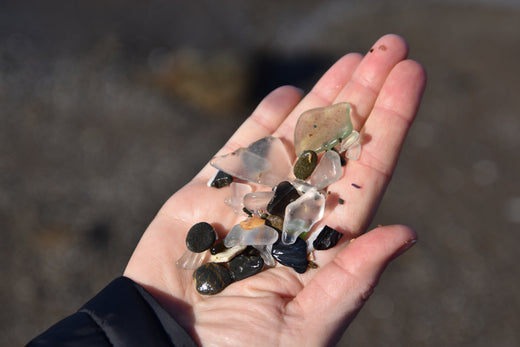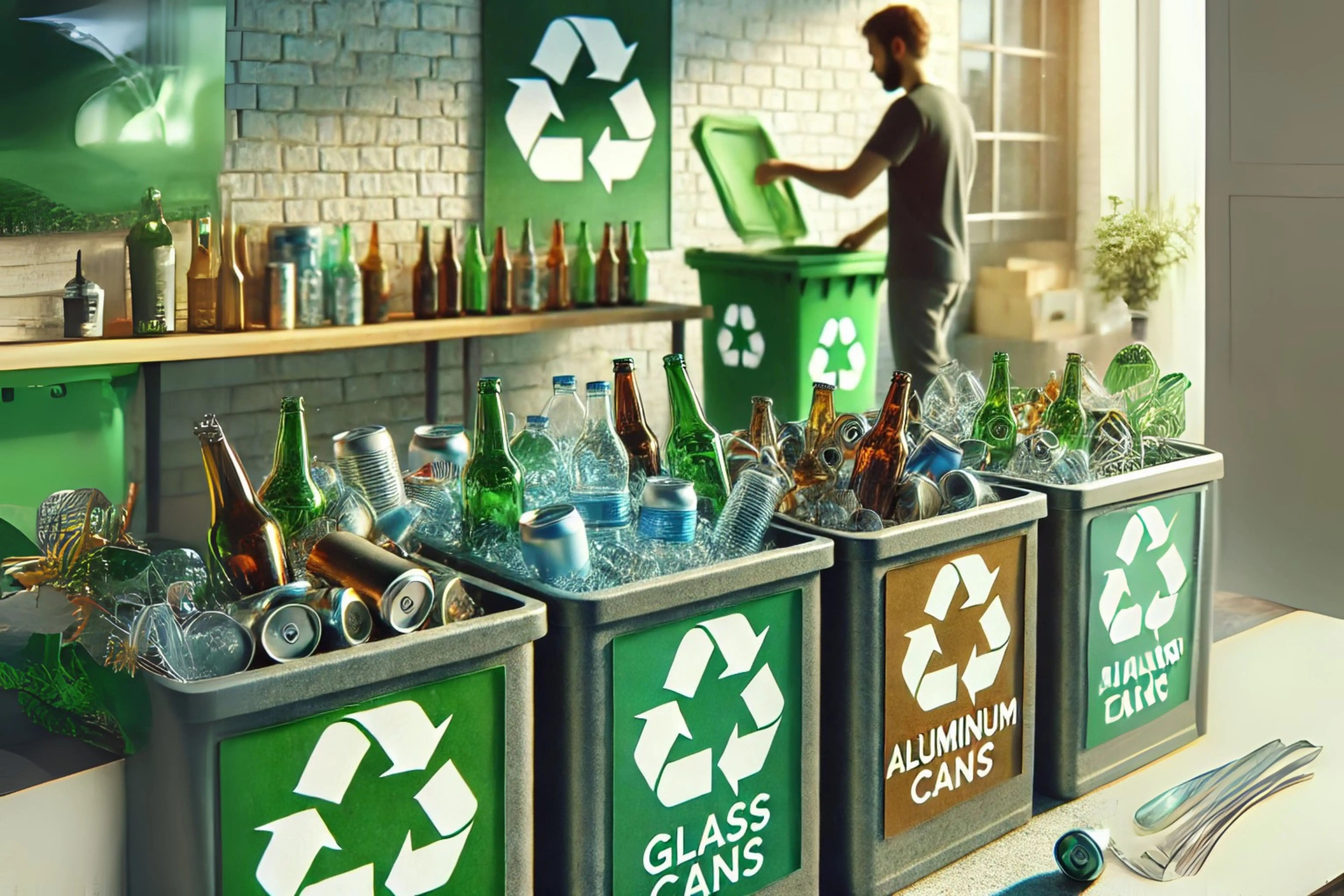Real sea glass is more than just a beautiful find on the beach—it’s a beautiful piece of history shaped by nature. These smooth, frosted gems have captured the hearts of glass collectors, jewelry designers, and environmentalists alike. But what exactly is sea glass, and why is it so enchanting? We’ll uncover the origins, value, rarity, and stunning sea glass colors while answering all your questions.
What Is Sea Glass?
Sea glass refers to pieces of glass that the ocean has naturally weathered. Over time, the movement of waves, combined with the abrasive action of sand and rocks, transforms jagged pieces of broken glass into smooth, frosted treasures.
Sea Glass vs. Beach Glass
While these terms are often used interchangeably, they’re not quite the same. Real sea glass is formed in salt water, which gives it a more polished and frosted appearance. Beach glass, on the other hand, is found in fresh water lakes and rivers, and its texture is usually less frosted due to the absence of salt.
How Is Sea Glass Made?
The creation of these glass gems is a slow and natural process that can take decades, even centuries. It begins with a piece of glass entering the ocean—often discarded as trash. Waves tumble the glass against sand and rocks, smoothing its sharp edges. Over an extended period of time, the saltwater chemically alters the surface, creating the frosted appearance that glass enthusiasts love.
It’s important to note that the process relies on human impact. While pollution creates sea glass, it also highlights the need for environmental conservation.
What Is Sea Glass Made Of?
Beautiful sea glass comes from a variety of sources, including:
- Glass Bottles: Glass pieces of soda, beer, and wine bottles are some of the most common origins.
- Tableware: Quality pieces of broken dishes, glasses, and decorative glass.
- Industrial Glass: Slag glass from factories or shipwrecks can occasionally be found.
Most sea glass is made from silica-based glass, often mixed with soda and lime to create durability.
Is Sea Glass Rare?
Sea glass is a rare treasure because the sea has tumbled it for years. Sea glass has existed for centuries, but the first recorded discovery was in 1787. Sea glass results from the natural process of waves crashing against rocks on the seashore, which smooths and polishes pieces of broken bottles, pottery, and other objects until they become smooth and rounded like pebbles.
The rarity of sea glass depends on several factors:
- Color: Some colors, like green and brown, are relatively easy to find, while red and orange are exceptionally rare.
- Age: Older pieces are becoming harder to locate due to reduced glass production and environmental cleanup efforts.
- Location: Remote or less frequently visited beaches may yield rarer finds.
As pollution decreases and glass products are replaced by plastic, sea glass is becoming increasingly rare—a bittersweet reality for collectors.
How Much Is Sea Glass Worth?
The value of sea glass depends on several factors:
1. Color
- Common Colors: Green, brown, and white (from beer bottles, medicine containers, and clear jars) are the most abundant and less valuable.
- Rare Colors: Cobalt blue, red, orange, and purple are highly sought after. Red, for instance, often comes from old taillights or vintage glassware.
2. Condition
The smoother and more frosted the glass, the higher its worth. Pieces with chips or sharp edges are typically less valuable.
3. Rarity
Sea glass that originates from discontinued products or historical shipwrecks can fetch a premium. For example, multicolored pieces or those with embossed lettering are particularly rare.
In general, common sea glass can sell for a few dollars per piece, while rare colors or large, flawless pieces can be worth $50 or more.
What Colors Is Sea Glass Found In?
Sea glass comes in a variety of colors, each telling a unique story of its origin:
- Green: Derived from beer bottles and soda bottles.
- Brown: Often from medicine bottles or beverage containers.
- White: The remnants of clear jars, tableware, or window panes.
- Cobalt Blue: Rare and linked to Noxzema jars, medicine bottles, or old soda bottles.
- Red: Extremely rare, often from vintage glass taillights or signal lanterns.
- Orange and Purple: Among the rarest colors, often found in older or specialty glass products.
How to Find Sea Glass: Tips for Collectors
Want to try your luck at finding sea glass? Here are some tips:
- Choose the Right Location: Beaches with high wave activity, rocky shores, and nearby historical sites are often the best spots. One of the most famous places for sea glass hunting is Glass Beach in California. Located near Fort Bragg, this iconic destination for glass hunters is known for its abundance of colorful sea glass, remnants from years of ocean-tumbled glass waste. While glass collecting is prohibited to preserve the site, visiting Glass Beach offers a stunning view of nature’s artistry and inspires collectors worldwide.
- Go at Low Tide: More sea glass is exposed when the tide is out.
- Look After Storms: Storms churn up the ocean, bringing new treasures to shore.
Fun Facts About Sea Glass
- History in Every Piece: Some sea glass originates from products over 100 years old, carrying a piece of history with it.
- Multicolored Sea Glass: Rare pieces feature two or more colors, often from fused glass fragments.
- Sea Glass Festivals: Collectors and enthusiasts celebrate these treasures at annual festivals worldwide.
How to Identify Genuine Sea Glass
Identifying natural sea glass is essential for collectors and enthusiasts alike. While many pieces may look authentic, some are actually artificial sea glass, created through man-made processes like placing shards of glass in an acid bath or a rock tumbler to mimic the real thing. Understanding the key characteristics of naturally tumbled sea glass can help you distinguish genuine treasures from these imitations.
Authentic sea glass is easy to spot if you know what to look for:
- Frosty Appearance: Genuine pieces have a naturally frosted, matte surface.
- Smooth Edges: The rounded edges are the result of years of tumbling in the ocean waves.
- Pitted Surface: Small divots caused by saltwater corrosion are a key identifier.
Avoid pieces with shiny, sharp edges or perfect shapes—these are artificial sea glass.
Environmental Significance of Sea Glass
Sea glass highlights the environmental impact of human behavior. While these treasures are beautiful, they’re also reminders of the pollution that once entered our oceans. By appreciating sea glass, we can also learn the importance of keeping our oceans and other bodies of water clean.
Sea Glass Jewelry and Crafting
Sea glass isn’t just for collecting—it’s also a popular material for creating unique, sustainable jewelry and décor. Many crafters use sea glass to make necklaces, earrings, and mosaics. Proper cleaning and preservation are essential to keep its beauty intact.
The Future of Sea Glass
As glass becomes less common and cleanup efforts increase, sea glass becomes a finite resource. For collectors, this means that pieces found today may become even more valuable in the future.
Conclusion: Why Sea Glass Captivates Us All
Sea glass is more than just a pretty object—it’s a connection to the past, a product of nature’s artistry, and a reminder of our responsibility to the environment. Whether you’re a seasoned collector or a curious beachgoer, the magic of sea glass will always inspire wonder and appreciation.
Happy glass hunting!




